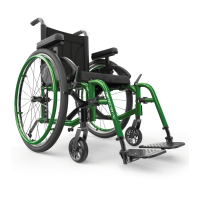TIE DOWNS – FOLDING WHEELCHAIRS | USER MANUAL
35
T 1-866-650-6555 F 1-888-966-6555 E-mail info@motioncomposites.com
Position the anchor points for the rear tie-down straps directly
behind the rear securement points on the wheelchair. The front
tie-down straps should anchor to floor points that are spaced wider
than the wheelchair to provide increased lateral stability.
See figure 2.
ATTENTION
Always allow for proper clear zones when securing an
occupied wheelchair in a motor vehicle. The frontal clear
zone (FCZ) is measured from the forward most point on the
occupant’s head and should measure at least 26 in. (66 cm) if
both a vehicle-anchored pelvic and upper-torso belt are used.
See figure 3.
The seated head height (HHT) ranges from about 47 in. (120 cm) for
a small adult female to about 61 in. (155 cm) for a tall adult male.
See figure 3.
WARNING
Allow as much clearance as possible around the wheelchair
occupant to reduce the possibility of contact with vehicle
components and other passengers in the event of a crash.
ATTENTION
Ensure all vehicle components that are in close proximity to
the wheelchair occupant are removed or covered with dense
padding.
MOTION COMPOSITES TRANSIT TIEDOWN PACKAGE
Rear Tie Down Front Tie Downt
The Motion Composites Transit Tie-Down Package includes belt
restraint anchor points in conformance with ANSI/RESNA WC/Vol.
4, Section 19.
8. SECURING THE WHEELCHAIR
OCCUPANT
Once the wheelchair has been properly secured, it is essential that
the wheelchair occupant be protected for transport.
WARNING
The pelvic belt should be angled between 45 and 75 degrees
to the horizontal when viewed from the side. However, if the
user cannot achieve this standard, an optional zone of 30 to
45 degrees can be utilized safely. Some wheelchair compo-
nents, like armrests and wheels, can interfere with proper
belt fit. It may be necessary to insert the belt between the
armrest and the seatback or through openings between the
backrest and seat in order to avoid placing the pelvic belt
over the armrest. See figure 5.
Figure 2. Securing the Wheelchair
FRONT OF VEHICLE
igure 3
HHT
FCZRCZ
FCZ
RCZ
FCZ = FRONTAL CLEAR ZONE
RCZ = REAR CLEAR ZONE
HHT = SEATED HEAD HEIGHT
CENTER
Figure 4. Tie Down Location
FRONT OF VEHICLE
30˚
45˚
75˚
Prefered Zone
Optimal Zone
igure 5. Recommended Pelvic Belt Placement Angles

